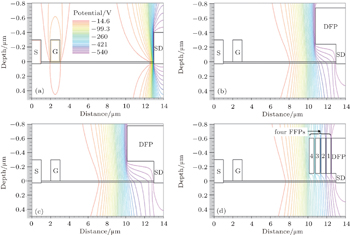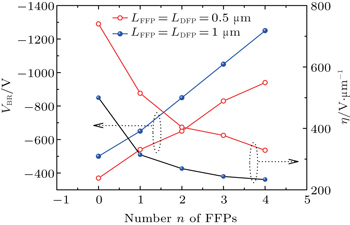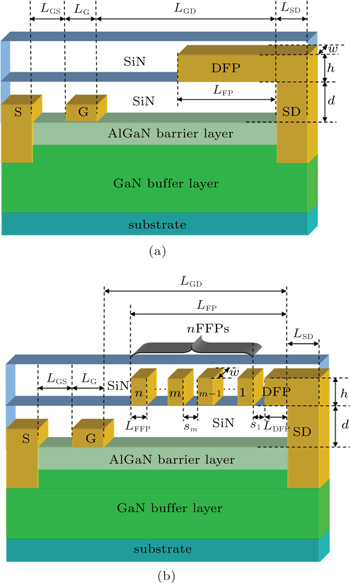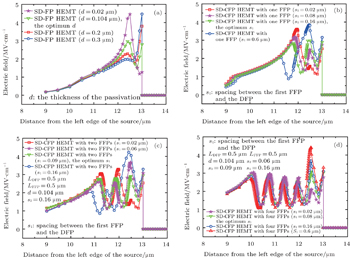† Corresponding author. E-mail:
Project supported by the National Natural Science Foundation of China (Grant Nos. 61204085, 61334002, 61306017, 61474091, 61574112, and 61574110).
In this paper, a novel AlGaN/GaN HEMT with a Schottky drain and a compound field plate (SD-CFP HEMT) is presented for the purpose of better reverse blocking capability. The compound field plate (CFP) consists of a drain field plate (DFP) and several floating field plates (FFPs). The physical mechanisms of the CFP to improve the reverse breakdown voltage and to modulate the distributions of channel electric field and potential are investigated by two-dimensional numerical simulations with Silvaco-ATLAS. Compared with the HEMT with a Schottky drain (SD HEMT) and the HEMT with a Schottky drain and a DFP (SD-FP HEMT), the superiorities of SD-CFP HEMT lie in the continuous improvement of the reverse breakdown voltage by increasing the number of FFPs and in the same fabrication procedure as the SD-FP HEMT. Two useful optimization laws for the SD-CFP HEMTs are found and extracted from simulation results. The relationship between the number of the FFPs and the reverse breakdown voltage as well as the FP efficiency in SD-CFP HEMTs are discussed. The results in this paper demonstrate a great potential of CFP for enhancing the reverse blocking ability in AlGaN/GaN HEMT and may be of great value and significance in the design and actual manufacture of SD-CFP HEMTs.
More and more attention has been paid to AlGaN/GaN HEMTs due to their superiorities of high breakdown electric field and high electron saturation velocity as well as high carrier density for RF power and power electronics applications. [ 1 – 4 ] Recently, the actual demands of good reserve blocking capability in power converters, [ 5 ] class-S amplifier, [ 6 ] power management systems, [ 7 – 9 ] and so on, have been one of the most important catalysts for studies of various kinds of Schottky drain (SD) in AlGaN/GaN HEMTs (SD HEMTs). [ 10 – 14 ] These studies revealed that the improvement of reserve blocking capability with SD is mainly attributed to the formation of the depletion region around the drain, effectively suppressing the buffer leakage. However, the ability of SD to enhance the reverse breakdown voltage V BR is limited because of its limited depletion region under reverse bias. Field plates (FPs), widely used in AlGaN/GaN HEMTs to improve the forward blocking capability, [ 15 – 19 ] could be promising techniques with great potential in SD HEMTs. A significant increase in reverse breakdown voltage for SD HEMTs by means of a drain FP (DFP) has been observed. [ 20 ] Nevertheless, similar to the FP in the forward blocking applications, the DFP may suffer the same troubles of the decreasing breakdown voltage increment with the increasing FP length in the reverse blocking applications. [ 16 , 21 ] Multiple FPs [ 18 ] may be a possible technique to solve this trouble by continually increasing the number of FPs. Unfortunately, the more FPs we use in multiple FPs HEMT, the more complex the device fabrication will be. Thus, much more effective FP structures deserve to be explored so as to further improve the reverse blocking capability.
In this paper, a novel SD HEMT with a compound FP (CFP) is proposed for the purpose of better reverse blocking enhancement. The proposed CFP is composed of a DFP and several floating field plates (FFPs) based on the inspiration from field-limiting rings. [ 22 ] The simulations of physical mechanism in SD HEMT with a CFP (SD-CFP HEMT), relating to the improvement of the reverse blocking capability together with the CFP modulation effects on the channel electric field and potential distributions, are investigated in detail by Silvaco-ATLAS. Moreover, the optimization methods containing two key and useful laws, and the relationship between the number of the FFPs and the reverse breakdown voltage as well as the FP efficiency in SD-CFP HEMTs are achieved based on our simulation results. These results above are of great value for the design and actual manufacture processes of SD-CFP HEMTs.
Figure
Except the FP structure, all the devices in this paper have the same epilayer heterostructure and device structure, including a 2-μm unintentionally doped (UID) GaN buffer layer, a 20-nm UID Al 0.3 Ga 0.7 N barrier layer, and a Schottky drain, which is similar to our early study. [ 20 ] Table
| Table 1. Meanings of some main structure parameters in Fig. |
The simulations are performed with help of Silvaco-ATLAS. The background doping concentrations in the AlGaN layer and the GaN layer are both assumed to be 1 × 10 15 cm −3 . The positive charge with a density of 1 × 10 13 cm −2 is located along the AlGaN/GaN heterojunction to model the polarization effect, which is based on the experimental result of the approximate charge neutrality at the AlGaN/passivation layer interface. [ 23 ] The Shockley–Read–Hall recombination model and the Caughey and Thomas field-dependent mobility model are included in the simulations. The Van Overstraeten–de Man impact ionization model, described as α = α 0 exp (− E c / E ), where α is the ionization coefficient and E is the electric field, is used to calculate the impact ionization rate with measured α 0 = 2.9 × 10 8 cm −2 and E C = 3.4× 10 7 V/cm. [ 24 ] The simulations about the breakdown performance are carried out with the gate biased at −6 V and the reverse breakdown voltage V BR is defined as the reverse drain voltage at which the peak electric field in the channel reaches the GaN breakdown field of 3 MV/cm.
Several device parameters, including the SiN passivation thickness d and the spacing s m between two adjacent FFPs, have been optimized in order to make every main channel electric field peak reach 3 MV/cm and obtain the maximum V BR . Figure
In order to obtain physical insight into the essential mechanism of the modulation of the FFPs, the potential distributions at off-state corresponding to the four devices in Fig.
 | Fig. 3. Potential distributions in four HEMTs: (a) SD HEMT, (b) SD-FP HEMT with 2.2-μm DFP, (c) SD-FP HEMT with 2.86-μm DFP, (d) SD-CFP HEMT with four FFPs. |
In the SD-CFP HEMTs, there are many parameters needed to be considered during the device optimization. Therefore, the SD-CFP HEMTs with different numbers of FFPs are investigated so as to reveal the optimization procedure. After our systematic studies, two key and useful laws are found. The first law is that the passivation layer thickness d is independent of the number of FFPs, which indicates that the SD-CFP HEMTs with different number of FFPs have the same optimum d as long as all the devices have the same main structure as the DFP and all the FFPs have the same size. Based on this law, if an optimum d is obtained in an SD-CFP HEMTs with one FFP, the d could be used directly as the optimum passivation layer thickness in SD-CFP HEMTs with n FFPs. This could be illustrated in Fig.
 | Fig. 4. Channel electric field distributions for the optimized SD-CFP HEMTs with different number of FFPs. L DFP = L FFP = 0.5 μm, d = 0.104 μm in all devices. |
| Table 2. Characteristics of the optimum spacing s i in the optimized SD-CFP HEMTs with different number of FFPs. L DFP = L FFP = 0.5 μm, d = 0.104 μm in all devices. . |
In order to evaluate the ability of SD-CFP to improve the reverse breakdown voltage reasonably, the FP efficiency, [ 16 ] defined as a ratio of the increment of the breakdown voltage to the total FP length L FP is utilized. Figure
 | Fig. 6. Relationship between the number n of FFPs and the reverse breakdown voltage V BR as well as the FP efficiency η in SD-CFP HEMTs. |
It is worth mentioning that the modulation effect of FFPs on the channel electric field mainly depends on the electrostatic induction between two adjacent FFPs as well as between the DFP and the first FFP. The electrostatic induction approximately increases with the couple capacitance C m across two adjacent FFPs, denoted roughly by C m = ε 0 ε ox hw/s m , where ε 0 is the vacuum permittivity, ε ox = 7.5 is the dielectric constant of the SiN passivation layer, s m is the spacing between the No. m FFP and the No. m − 1 FFP, h and w are the thickness and width of FFPs, respectively. Thus, in actual device design, based on the simulation results, one could raise s m by increasing h or w , without changing the value of C m so as to remain the same breakdown voltage. For example, if the width w of FFPs is set to be 10 μm, in the actual device w is usually much larger than 10 μm, the optimum spacings for SD-CFP HEMTs with four FFPs in Table
The reverse blocking performance of the SD-CFP HEMT with a CFP consisting of a DFP and several FFPs has been investigated in this paper. Based on two-dimensional simulations, SD-CFP HEMTs exhibit a good reverse blocking capability compared with SD HEMTs and SD-FP HEMTs. This is attributed to the fact that the CFP could effectively modulate the potential distributions so as to extend the whole electric field distribution between gate and drain and to make all the electric field peaks around the edges of DFP, FFPs, and SD approximately equal but less than breakdown field. The breakdown voltage of SD-CFP HEMT could increase continuously and linearly with the increasing number of FFPs, which is an amazing and valuable feature to easily design many devices with much higher breakdown voltage. Simulation results also suggest that the passivation layer thickness is independent of the number of FFPs and the optimum spacing s n in devices with n FFPs is equal to the optimum spacing s n −1 in devices with n − 1 FFPs. Moreover, the optimum s i could be raised by increasing h or w , without changing the value of couple capacitance C m so as to remain the same breakdown voltage. This may provide a useful guideline to reduce the device design complexity and simplify actual manufacture processes of SD-CFP HEMTs. Furthermore, simulations about the relationship between the number of FFPs, the reverse breakdown voltage and the FP efficiency in SD-FFP HEMTs are carried out, which could offer a proper trade-off between these parameters for device designers.
| 1 | |
| 2 | |
| 3 | |
| 4 | |
| 5 | |
| 6 | |
| 7 | |
| 8 | |
| 9 | |
| 10 | |
| 11 | |
| 12 | |
| 13 | |
| 14 | |
| 15 | |
| 16 | |
| 17 | |
| 18 | |
| 19 | |
| 20 | |
| 21 | |
| 22 | |
| 23 | |
| 24 |





